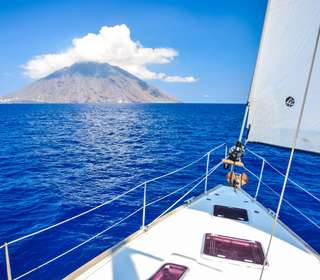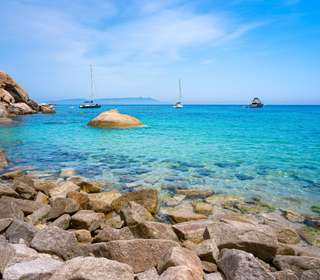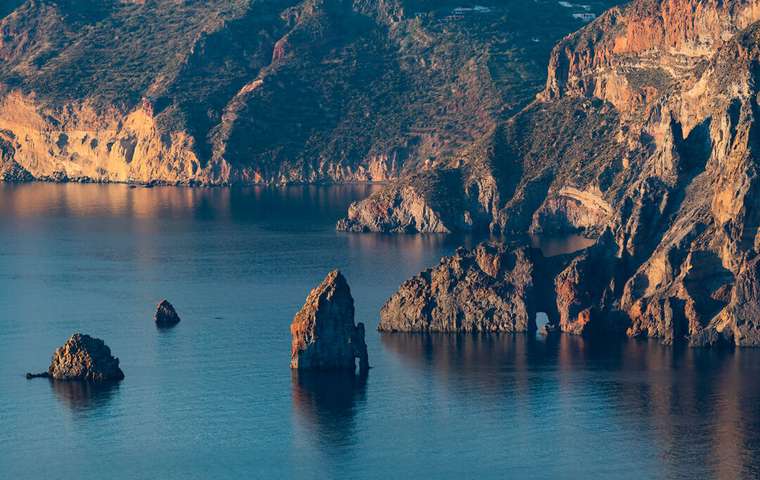
Guide to the most beautiful islands of the Aeolian Islands
Stromboli, Vulcano and Lipari are just some of the best destinations for a sailing or catamaran vacation in Sardinia
The Aeolian Islands, north of Sicily, are a must for all lovers of the sea and sailing. The archipelago of volcanic origin, declared a UNESCO World Heritage Site, consists of seven very different islands, much appreciated by the jet set for their somewhat wild beauty. Even their name evokes myths and legends; in fact, they owe their name to Aeolus, god of wind, who has always reigned supreme, along with the god of fire. The four elements meet here, making these islands magical and characterizing the territory that varies from sheer cliffs to black beaches and rocks of various colours, from the white of pumice to the red of basalt and the gold of sulphur.
An exclusive landscape that only a sailing vacation can reveal all its intensity, making even the most remote places accessible.
Best period
In the Aeolian Islands you can sail in peace from April to October, thanks to the temperate climate and constant winds. The summer months are the most popular, and thanks to the sea breeze you will never find scorching heat. Those who prefer a quieter vacation can opt for the spring months and enjoy the colours and scents of the islands' rich vegetation, or the colours and warm sea of autumn
Vacation highlights in the Aeolian Islands
Travel Ideas
The Aeolian Islands guarantee the right mix of relaxation, nature and fun. Free spirits will be fulfilled by hours spent sailing between islands and off-the-beaten-path roadsteads; those seeking out-of-the-ordinary experiences will find Stromboli and Vulcano to be their bread and butter, while the more sociable will be enraptured by the vibes of fashionable Panarea. Not enough? Add stunning coastlines and seabeds, almost exotic vegetation, lonely villages and archaeological treasures.
Sustainable tourism
The seven islands of the archipelago were declared UNESCO World Heritage Sites in 2000 for the important evidence of existing volcanic phenomenology. They are a land of study for numerous geologists and volcanologists from all over the world. Stromboli, unique in its kind, is among the most active volcanoes in all of Europe, with eruptions every 10 to 20 minutes.
Perfect for
The Aeolian Islands, so different from each other, complement each other and manage to satisfy precisely those who want (and are ready) for a little bit of everything. Perfect for groups of friends, suitable for young and old.
Families with children may not have many opportunities to go ashore and always find shallow waters.
Perfect choice, finally, for those who want to learn more about sailing, because the islands are a few hours apart, a perfect condition for getting some practice!
First time on a boat
The Aeolian Islands are among the top 3 most popular Italian destinations for sailing vacations in the summertime, usually characterised by constant but never excessive wind. However, they are islands that are relatively far from the mainland, and weather conditions can change very quickly, making it difficult to find moorings in small ports, especially in high season, or to follow the stages set out on departure. If you are ready to experience true sailing that can also take you to paradise in a few hours of sailing, then the Aeolian Islands are for you.

Travel Stories
A holiday in the Aeolian Islands to the rhythm of music... among spectacular volcanoes and seabeds full of life, among Sicilian cannoli, pane cunzato and Malvasia. What better way to discover the '7 Sisters' than on a sailing boat with a crazy crew! Every day a different island, many things to do and a thousand places to see. Here is the on-board account of an unforgettable holiday.
To know for a boating holiday in the Aeolian Islands

Movie Islands
In 1994 Salina was chosen as a destination for the production of a cinematic masterpiece. It is precisely in Pollara that the film "Il Postino", based on a novel by Antonio Skarmeta, inspired by Pablo Neruda's exile and starring Massimo Troisi, was set. The house where the filming took place is every year a destination for many visitors who love the film, the tranquility of the place, attracted by the smells and colors of broom, heather and caper flowers.
Besides Salina, Lipari, Vulcano and Stromboli have also been chosen as sets by great directors such as Nanni Moretti, William Dieterle and Roberto Rossellini.

Stromboli and the Sciara del Fuoco
The Sciara del Fuoco is a natural slide that was formed thousands and thousands of years ago. Its name means "road of fire", and it perfectly renders the idea of what can be seen when the volcano is active. On this stretch lava flows and combines with lapilli, and fiery red rocks that combine with the blue of the sea giving a unique spectacle. Since these eruptions are rather contained although persistent (that is why they are called "puffs"), it is possible to admire this spectacle up close, aboard a sailboat. Even more impressive is to witness this phenomenon in the night hours.

Sea Ox Cave in Filicudi
It is located on the western side of the island and is the largest cave of all the Aeolian Islands. It is 20 metres high and 30 metres wide, and inside you can admire special light effects. The name comes from the way fishermen called the monk seal that lived there. Another legend claims that the name comes from the sound of the waves breaking inside the cave, similar to the cry of an ox.
Relax, nature and fun in the Aeolian Islands




7+
Show all
Aeolian Islands by boat
7 curiosities for 7 islands
Lipari
Lipari is the largest and most populated island, often chosen as a starting point for sailing vacations. It is home to several must-see beaches and coves: Ponticello, a mix of gravel, pumice stone and sand; the white beach of Papesca; Acquacalda, overlooked by a distinctive white mountain of pumice stone; and Canneto, suitable for families with children.
According to Greek mythology, the god Aeolus (after whom the archipelago is named) lived on Lipari itself and was able to predict weather conditions by observing precisely the shape of clouds puffed out by an active volcano, probably Stromboli.
Vulcano
The island of Vulcano, with its primordial atmosphere and landscapes of almost hostile charm, is home to some unmissable sights Among these are the black-sand Donkey beach, the thermal baths of Vulcano, natural pools of hot mud, and the crater of the volcano, which can be reached by a hike, during which you can enjoy the best view of the 'archipelago.
The island's name has mythological origins: the Greeks placed the forges of the god Hephaestus right here, who with the Cyclops forged weapons for the gods; later the Romans renamed it with the name Vulcano.
Panarea
The smallest and most worldly island in the archipelago. Among the most popular beaches you can find Cala Junco and Punta Milazzese, not far from the prehistoric village. By sailboat you can reach the beautiful islets of Basiluzzo, Lisca Bianca and Dattilo.
Diving enthusiasts near Lisca Bianca can visit the wreck of the Lanishen, a merchant ship that sank in the early 1900s after hitting the rocks. The state of preservation of the stern and bow sections is good, while the central part has become home to hundreds of moray eels, damselfish and groupers.
Stromboli
Also called Iddu in Sicilian, Stromboli is one of the most active volcanoes in the world. It is nicknamed the "lighthouse of the Mediterranean" because of its constant activity and visibility. The more athletic, equipped with hiking shoes, can climb to the top of the Stromboli volcano and enjoy breathtaking views.
But the must-do is sailing under the "Sciara del Fuoco", a slope of ash and lava that plunges from the volcano into the sea, continuing on to the islet of Strombolicchio, formed by the magma residue of the original volcanic chimney, dating back 200,000 years.
The village of Ginostra, accessible by sailboat, is famous for the Pertuso that entered the Guinness Book of Records for being the smallest port in the world; today it has been expanded and can also be reached by ferry.
Salina
Salina is the greenest island in the Aeolian Islands and owes its name to a small coastal brackish lake in the hamlet of Lingua, which was once used as a salt marsh and is now a protected nature reserve. Between bays, inlets and crystal-clear waters, it holds little secrets inland and along the coasts, to be discovered by walking one of the many paths that crisscross the island.
Salina is the home of Malvasia, the so-called "nectar of the gods," but also of the caper, which thanks to the characteristics of the soil, cultivation and conservation make it a unique product and the very emblem of the island.
Filicudi
A small natural paradise with a wild and timeless soul, where peace and tranquillity reign supreme. In fact, the island is populated by few inhabitants, settled mostly in Filicudi Porto. In addition to the famous Grotta del Bue Marino (Sea Ox Cave), two stops not to be missed are Faraglione La Canna and Scoglio di Montenassari, which can only be reached by sea.
Faraglione La Canna is nicknamed the guardian of Filicudi because of its shape reminiscent of the Madonna and Child. In fact, a popular legend says that just touching the rock is enough to make wishes come true.
Alicudi
The island is located in the westernmost part of the archipelago, yet has been inhabited and cultivated since ancient times. Its name derives from "Ericusa" because of the large number of heaters in the area. It is the "zero-pollution" island; there is a complete lack of carriageable roads, so no cars and mopeds (except for a very short stretch in the harbour). To tackle lava stone steps and mule tracks that connect the port to Contrada Tonna, San Bartolo to Pianicello, you rely on your feet and donkeys bred on the island.
Guides & tips

Where to travel
Italy on a sailing boat

Where to travel
Tuscan Archipelago by sailboat

Where to travel
Sardinia on a sailing boat

Where to travel
Capri, Ischia and Procida by sailboat
Let's talk Sailsquare!



Secure payments



© 2025 Sailsquare Srl SB • All rights reserved - VAT IT07860990964














